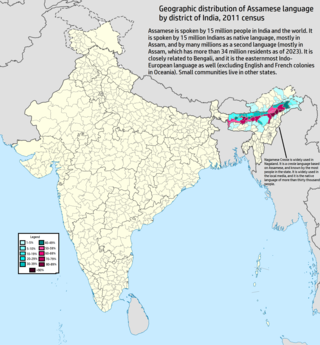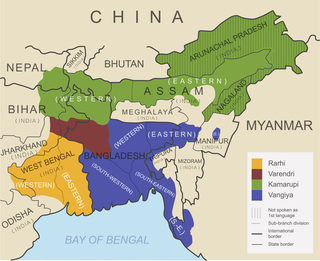
Assamese, also Asamiya ( অসমীয়া), is an Indo-Aryan language spoken mainly in the north-eastern Indian state of Assam, where it is an official language, and it serves as a lingua franca of the wider region. The easternmost Indo-Iranian language, it has over 15 million speakers according to Ethnologue.

Sylheti is an Indo-Aryan language spoken by an estimated 11 million people, primarily in the Sylhet Division of Bangladesh, Barak Valley of Assam, and northern parts of Tripura in India. Besides, there are substantial numbers of Sylheti speakers in the Indian states of Meghalaya, Manipur and Nagaland as well as diaspora communities in the United Kingdom, the United States, Canada and the Middle East.
A.tong is one of the Garo dialect Sino-Tibetan language which is also related to Koch, Rabha, Bodo other than Garo language. It is spoken in the South Garo Hills and West Khasi Hills districts of Meghalaya state in Northeast India, southern Kamrup district in Assam, and adjacent areas in Bangladesh. The spelling "A.tong" is based on the way the speakers themselves pronounce the name of their language. There is no glottal stop in the name and it is not a tonal language.
In an alphabetic writing system, a silent letter is a letter that, in a particular word, does not correspond to any sound in the word's pronunciation. In linguistics, a silent letter is often symbolised with a null sign U+2205∅EMPTY SET. Null is an unpronounced or unwritten segment. The symbol resembles the Scandinavian letter Ø and other symbols.

Bishnupriya Manipuri, also known as Bishnupriya Meitei or simply as Bishnupriya, is an Indo-Aryan lect belonging to the Bengali–Assamese linguistic sub-branch. It is a creole of Bengali language and Meitei language and it still retains its pre-Bengali features. It is spoken in parts of the Indian states of Assam, Tripura and Manipur as well as in the Sylhet Division of Bangladesh. It uses the Bengali-Assamese script as its writing system. Bishnupriya Manipuri, being a member of the Eastern Indo-Aryan languages, was evolved from Magadhi Prakrit. So, its origin is associated with Magadha realm. The Government of Tripura categorised Bishnnupriya Manipuri under the "Tribal Language Cell" of the State Council of Educational Research and Training. Its speakers are also given the "Other Backward Classes" status by the Assam Government and notably, there is no legal status of the Bishnupriyas in Manipur. In the 2020s, the Bishnupriya speaking people started demanding that the Assam Government should give them the status of "indigenous people" of Assam and treat the same like other indigenous communities of the state.

Northern Qiang is a Sino-Tibetan language of the Qiangic branch, more specifically falling under the Tibeto-Burman family. It is spoken by approximately 60,000 people in East Tibet, and in north-central Sichuan Province, China.

Boro, also rendered Bodo, is a Sino-Tibetan language spoken primarily by the Boros of Northeast India and the neighboring nations of Nepal and Bangladesh. It is an official language of the Indian state of Assam, predominantly spoken in the Bodoland Territorial Region. It is also one of the twenty-two languages listed in the Eighth Schedule of the Constitution of India. Since 1975 the language has been written using the Devanagari script. It was formerly written using Latin and Eastern-Nagari scripts. Some scholars have suggested that the language used to have its own now lost script known as Deodhai.

The dialects of the Bengali language are part of the Eastern Indo-Aryan language group of the Indo-European language family widely spoken in the Bengal region of South Asia. The spoken dialects of Bengali are mutually intelligible with neighbouring dialects.
The phonology of Bengali, like that of its neighbouring Eastern Indo-Aryan languages, is characterised by a wide variety of diphthongs and inherent back vowels.

Aguaruna is an indigenous American language of the Chicham family spoken by the Aguaruna people in Northern Peru. According to Ethnologue, based on the 2007 Census, 53,400 people out of the 55,700 ethnic group speak Aguaruna, making up almost the entire population. It is used vigorously in all domains of life, both written and oral. It is written with the Latin script. The literacy rate in Aguaruna is 60-90%. However, there are few monolingual speakers today; nearly all speakers also speak Spanish. The school system begins with Aguaruna, and as the students progress, Spanish is gradually added. There is a positive outlook and connotation in regard to bilingualism. 50 to 75% of the Aguaruna population are literate in Spanish. A modest dictionary of the language has been published.
Mal Paharia is a language spoken by 51,000 of 110,000 ethnic Mal Paharia in the states of Jharkhand and West Bengal in India, and regions of Bangladesh. The language is also known as Mal Pahoria, Malto, Malti, Paharia, Parsi, and Mal Pahariya. It has been variously regarded as a Bengali–Assamese language, a dialect of Malto, and a mixed Dravidian–Indo-Aryan language. There is a generally positive attitude among speakers of the language towards it, but it is considered vulnerable as some speakers have shifted to Bengali. Mal Paharia uses the Devanagari script and rules for its writing, reading, and speech.
The phonemic inventory of Maldivian (Dhivehi) consists of 29 consonants and 10 vowels. Like other modern Indo-Aryan languages the Maldivian phonemic inventory shows an opposition of long and short vowels, of dental and retroflex consonants as well as single and geminate consonants.

Bengali, generally known by its endonym Bangla, is an Indo-Aryan language native to the Bengal region of South Asia. With approximately 234 million native speakers and another 39 million as second language speakers as of 2017, Bengali is the sixth most spoken native language and the seventh most spoken language by the total number of speakers in the world. Bengali is the fifth most spoken Indo-European language.

The Bengali script or Bangla alphabet is the alphabet used to write the Bengali language based on the Bengali-Assamese script, and has historically been used to write Sanskrit within Bengal. It is one of the most widely adopted writing systems in the world . It is one of the official scripts of the Indian Republic. It is used as the official script of the Bengali language in Bangladesh, West Bengal, Tripura and Barak valley of Assam as well as the Meitei language in Manipur, two of the official languages of India.
The Tanchangya language is one of the eleven indigenous languages in Chittagong Hill Tracts in present-day Bangladesh, and an ethnic group in the Indian states of Tripura and Mizoram, as well as Rakhine State in Myanmar. Despite commonly believe as Indo-Aryan language, it is categorized as aTibeto-Burman language. It is closely related to Chakma and Chittagonian.
Schwa deletion, or schwa syncope, is a phenomenon that sometimes occurs in Assamese, Hindi, Urdu, Bengali, Kashmiri, Punjabi, Gujarati, and several other Indo-Aryan languages with schwas that are implicit in their written scripts. Languages like Marathi and Maithili with increased influence from other languages through coming into contact with them—also show a similar phenomenon. Some schwas are obligatorily deleted in pronunciation even if the script suggests otherwise.

The Hajong people are an ethnic group from Northeast India and northern parts of Bangladesh. The majority of the Hajongs are settled in India and are predominantly rice-farmers. They are said to have brought wet-field cultivation to Garo Hills, where the Garo people used slash and burn method of agriculture. Hajong have the status of a Scheduled Tribe in India and they are the fourth largest tribal ethnicity in the Indian state of Meghalaya.

The Bengali–Assamese script, also known as Eastern Nagari, is a modern eastern Indic script that emerged from the Brahmi script. Gaudi script is considered the ancestor of the script. It is known as Bengali script among Bengali speakers, as Assamese script among Assamese speakers, and Eastern-Nāgarī is used in academic discourse.
The Ersu language proper is a Sino-Tibetan spoken in western Sichuan, China. It is the most widely spoken of the three Ersu languages. There are 13,000 speakers according to Sun (1982).

The Bengali–Assamese languages is a grouping of several languages in the eastern Indian subcontinent. This group belongs to the Eastern zone of Indo-Aryan languages. The languages in this group according to Glottolog includes Assamese, Bengali, Bishnupriya, Chakma, Chittagonian, Hajong, Kharia Thar, Kurmukar, Lodhi, Mal Paharia, Noakhailla, Rajbangshi, Rohingya, Sylheti, Tangchangya and Surjapuri.












